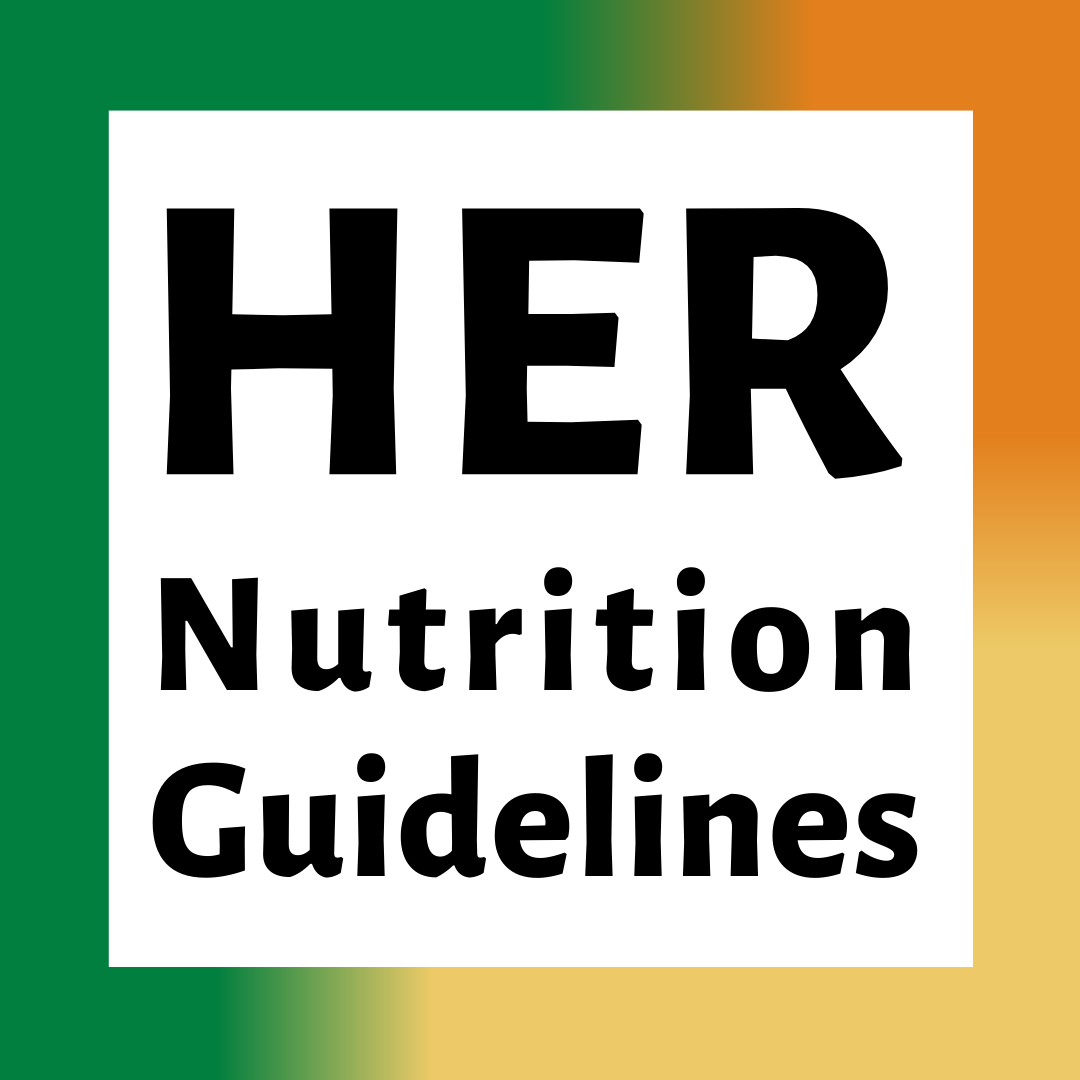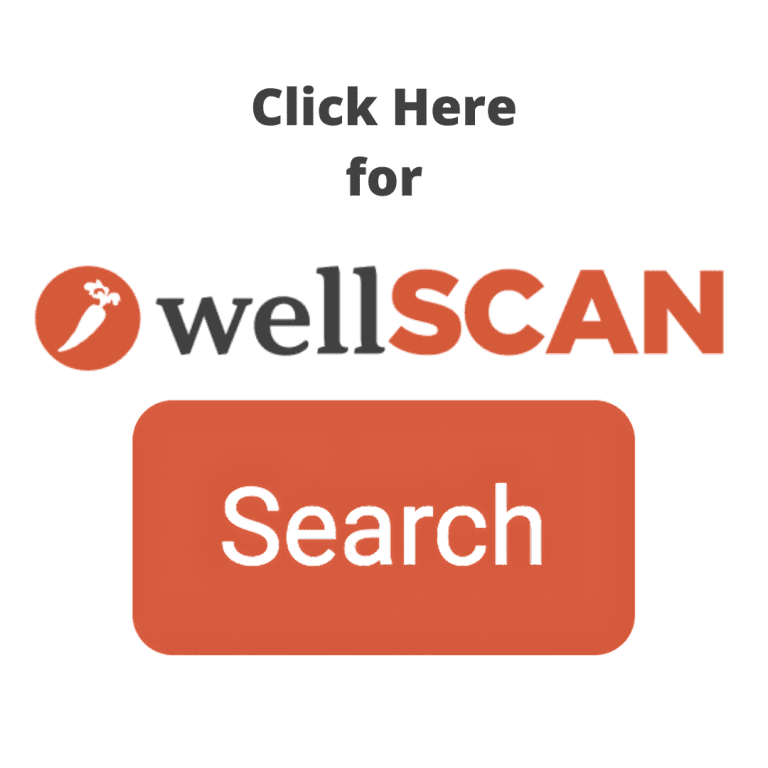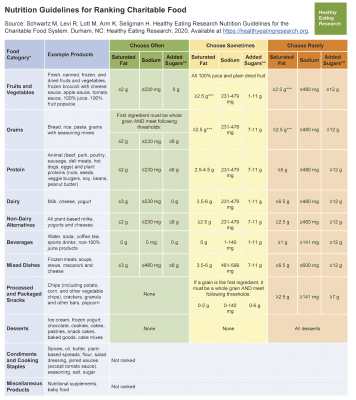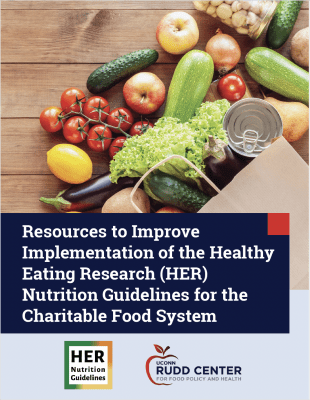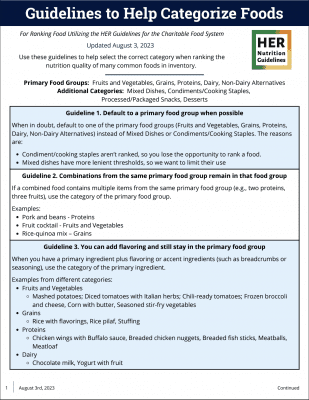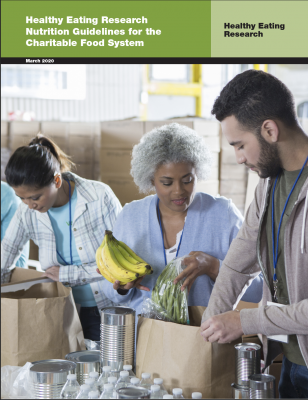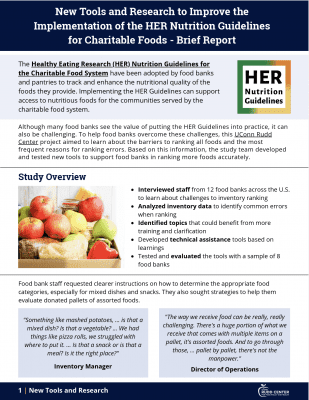HER Nutrition Guidelines - Tools for Food Banks and Pantries
If you are a researcher utilizing the HER Guidelines, please visit our "Tools for Researchers" page.
In 2019, Healthy Eating Research convened a panel of experts in the charitable food system, nutrition, and food policy fields to create clear, specific recommendations for evidence-based nutrition guidelines tailored to the unique needs and capacity of the charitable food system. The intent of these recommendations is to improve the quality of foods in food banks and pantries in order to increase access to and promote healthier food choices across the charitable food system, allowing all people in the United States—regardless of income—access to the foods necessary for an active, healthy life.
Dr. Marlene Schwartz - the Director of the Rudd Center - co-chaired this panel along with Hilary Seligman from the University of California, San Francisco. The full report with the panel's findings, "Healthy Eating Research Nutrition Guidelines for the Charitable Food System," was released in March 2020.
On this page, which is specifically designed for partners in the charitable food system, you will find:
- Resources that explain the HER Guidelines
- Tools to improve implementation in your food bank/food pantry
- Information about the Supporting Wellness at Pantries (SWAP) measure
- Tools for categorizing specific groups of foods
- Information about ranking and logging foods using the WellSCAN suite of tools
Resources
Understanding the Guidelines
Products are divided into 11 categories; and within categories, items are ranked into tiers of “choose often” (green columns), “choose sometimes” (yellow columns), and “choose rarely” (red columns) based on saturated fat, sodium, and added sugar nutrient thresholds. Product examples are provided for each of the 11 food categories to illustrate the types of items that would fall into each category. Additional details can be found in the full report.
The 11 categories of food are: Fruits and Vegetables, Grains, Protein, Dairy, Non-Dairy Alternatives, Beverages, Mixed Dishes, Processed and Packaged Snacks, Desserts, Condiments and Cooking Staples, and Miscellaneous Products.
The expert panel chose to focus primarily on these three nutrients to limit – saturated fat, sodium, and added sugar – based on evidence linking increased consumption to increased risk for diet-related chronic diseases, including obesity, diabetes, hypertension, and cardiovascular disease. The current thresholds for each are based on nutrients found in a single serving of food. Anchoring the guidelines to serving size allows straightforward identification of necessary information on the Nutrition Facts Label, and should make the system easier to implement.
One-Page Summary of Guidelines
Additionally, More than Food Consulting (in partnership with Feeding America), created two handouts to help partners understand and implement the HER Guidelines:
Resources to Improve Implementation
This guide contains training materials, resources, tips, and examples of practices to help food banks improve the implementation of Healthy Eating Research (HER) Nutrition Guidelines for the Charitable Food System. To create this guide, we interviewed people working in food banks across the country to learn how they approach ranking foods using the HER Guidelines. They shared their experiences, the challenges they face, and the practices that help with their work. We also analyzed these food banks’ inventory reports to identify specific categories of foods that are most confusing to rank and topics that needed clarification or more training. This resource was created as part of a research project supported by Healthy Eating Research, with funding from the Robert Wood Johnson Foundation (Award 81351).
Authors: Maria Gombi Vaca, Violeta Chacón, Isabelli Costa da Silva, Marlene Schwartz, Caitlin Caspi, Katie Martin, and Maisie Campbell
Additionally, if you are looking for specific training materials, we have divided the guide into 6 separate resources:
- HER Guidelines Basic Training
- Step-by-Step Guide to Ranking Foods
- Foods Always Ranked the Same
- Ranking Foods from USDA
- Common Challenges When Ranking
- Checking for Ranking Errors in Inventory Reports
Finally, we have created a two-page brief summarizing the results of this project, the contents of the guide, and the impact of the technical assistance that was provided to food banks:
Supporting Wellness at Pantries – SWAP
To improve communication of the nutrition ranking system to neighbors - either when launching these resources or when serving community members where there may be a language barrier - the Greater Chicago Food Depository developed SWAP Fact Sheets in 11 languages (English, Spanish, Chinese, Polish, Russian, Ukrainian, Arabic, Farsi, Dari, French, and Pashto). These single-sheet fliers provide a simple summary of what SWAP is, how rankings are assigned, why diet-related diseases are a concern, and what the Green, Yellow, and Red rankings mean. 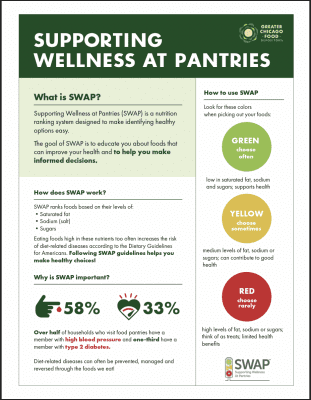
To supplement these fact sheets, their team developed short training videos for food bank staff, pantry staff and volunteers, which cover the community need for SWAP, how to rank foods, how to implement SWAP at pantries, and how to communicate SWAP rankings to neighbors. The videos are available in English and Spanish versions - with all on-screen text and voiceover narration translated - and can be downloaded or shared via Vimeo.
Video 1 – Introduction to SWAP
Video 2 – How to Rank Foods with SWAP
Video 3 – Pantry Implementation
Video 4 – SWAP Communication
Additionally, the More Than Food Consulting team partnered with Feeding America to develop resources about utilizing the HER Guidelines:
Tools for Categorizing Foods in the Charitable Food System
How to Prepare Your Data for HER Analyses:
- This document provides step-by-step instructions for preparing your data for HER analyses using FANO categories.
- It also provides the default rank for foods when applicable.
Guidelines to Help Categorize Foods
- This document can be used to help select the correct category when ranking the nutrition quality of many common foods.
- These guidelines were created by the Item Card Workshop.
Questions about these tools should be directed to Marlene Schwartz (marlene.schwartz@uconn.edu).
WellSCAN
WellSCAN is an ever-evolving suite of digital tools and products made to help food banks and food pantries better identify, rank, and log the nutritional quality of their inventory. Additionally, WellSCAN can be utilized by researchers looking to track the nutritional quality of foods offered by partners in the charitable food system.
WellSCAN's ranking technology can be accessed via the WellSCAN website on your computer or mobile device. Specific tools on the website include:
- Calculator: Input an item's food category and nutrition information to determine its HER rank
- Search: Lookup specific foods by name or UPC to find their HER rank
- Inventory Collection: Log the HER ranks of all items at a pantry/food bank
Acknowledgements: The Rudd Center created the WellSCAN suite of technology in partnership with the University of Connecticut Digital Experience Group. This project has been made possible with support from Partnership for a Healthier America, Feeding America, The Claneil Foundation, and the Robert Wood Johnson Foundation.
Contact: Questions about the WellSCAN suite can be directed to Marlene Schwartz (marlene.schwartz@uconn.edu)
